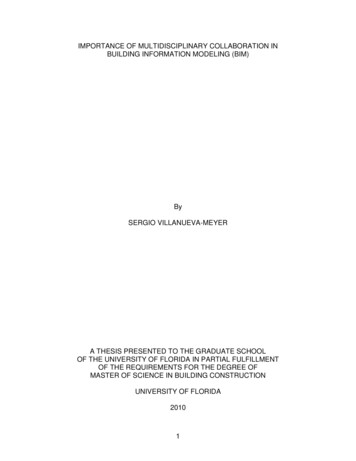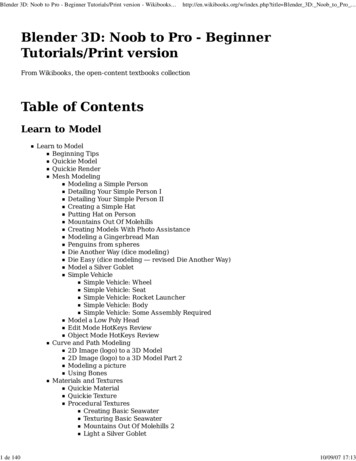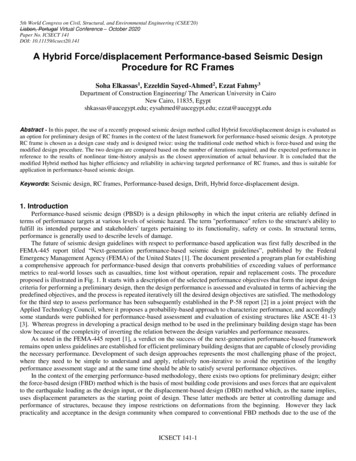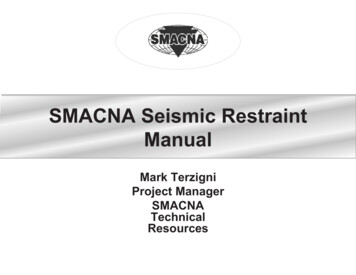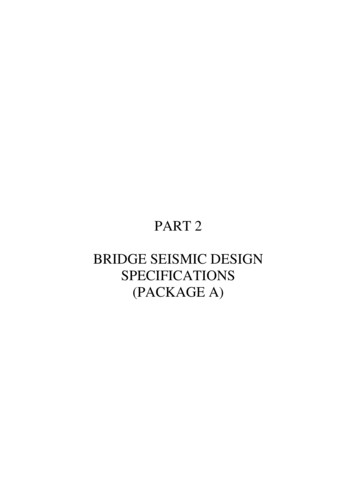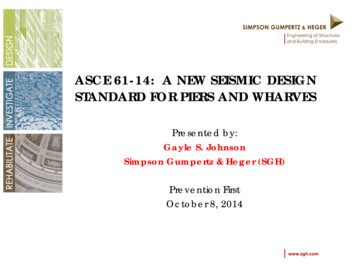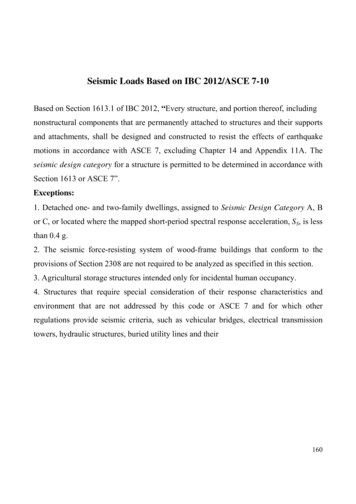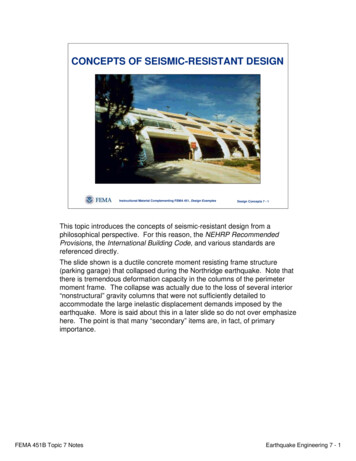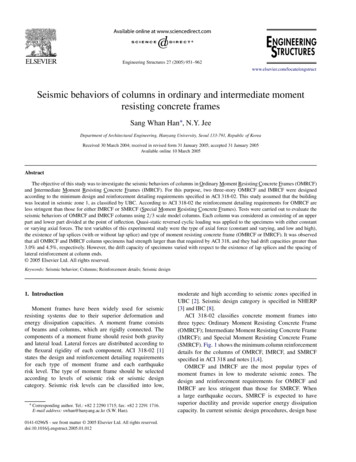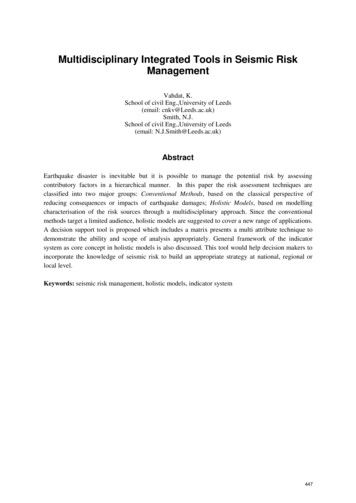
Transcription
Multidisciplinary Integrated Tools in Seismic RiskManagementVahdat, K.School of civil Eng.,University of Leeds(email: cnkv@Leeds.ac.uk)Smith, N.J.School of civil Eng.,University of Leeds(email: N.J.Smith@Leeds.ac.uk)AbstractEarthquake disaster is inevitable but it is possible to manage the potential risk by assessingcontributory factors in a hierarchical manner. In this paper the risk assessment techniques areclassified into two major groups: Conventional Methods, based on the classical perspective ofreducing consequences or impacts of earthquake damages; Holistic Models, based on modellingcharacterisation of the risk sources through a multidisciplinary approach. Since the conventionalmethods target a limited audience, holistic models are suggested to cover a new range of applications.A decision support tool is proposed which includes a matrix presents a multi attribute technique todemonstrate the ability and scope of analysis appropriately. General framework of the indicatorsystem as core concept in holistic models is also discussed. This tool would help decision makers toincorporate the knowledge of seismic risk to build an appropriate strategy at national, regional orlocal level.Keywords: seismic risk management, holistic models, indicator system447
1. IntroductionMaking decisions in high-seismic regions usually involves different considerations than in areaswithout any earthquake threat. Mitigation projects without effective risk assessment may fail toreduce the seismic risk and its consequences. Mora et al (2006) pointed out many reasons for lack ofproactive risk management and stressed on incorporating multi attribute factors of mitigation, such asfinancial and social protection to control the cause and consequence of seismic risk in early stage ofprojects. Chen et al (2005) developed an economical index (e.g. GDP) to address the significantincrease in loss due to earthquake events. Nevertheless, the performance of any risk analysis is mainlydependent upon the methodology used and the comprehensiveness of the available data to becollected from focused region. In the context of seismic risk due to large uncertainty in bothmethodology and hazard data, selecting the appropriate tools considering these issues seems to be acrucial decision.Traditionally, wide range of techniques is still available to estimate the seismic risk, regardless oftheir capability, effectiveness and degree of uncertainty; however, several studies have shown that fewtechniques could be used in practice effectively and efficiently. Moreover, the variety of tools anddata may be misleading in the selecting of appropriate technique by decision makers (DMs).Consequently, within different contexts, there is a strong need for a metric to be employed in riskidentification and assessment and registration. To cover this gap, a decision support tool is developed.This tool comprises a comparative matrix that assists DMs to choose appropriate techniqueconsidering different aspects of methodology, range of data, degree of subjectivity and scale ofanalysis.2. Risk and uncertaintyThe concept of risk can have variable meanings depending on the context either qualitativelyor quantitatively. The most common definition of risk states the risk as a product oflikelihood an event and consequence of it as displayed below:Risk Likelihood x Consequence (Ansell 1992; FEMA 2004)Based on the above definition the qualitative measures of seismic risk can be expressed in amatrix (Figure 1).In the risk matrix, the qualitative risk scale can be categorized as low,moderate and high which is the multiple product of severity of consequence and degree oflikelihood. For example, earthquake hazard is recognized as low-likelihood, highconsequence event and according to this matrix, it is deemed as a moderate risk.448
Figure 1: Qualitative expression of seismic risk (FEMA 2004)In contrast, quantitative definition of risk, which is described by Varnes (1984) considers risk as aproduct of "V vulnerability", "H hazard" and "E exposed elements or assets" in equation of R HxVxE. This expression has gained international acceptance according to UNDRO (1982) andadopted by FEMA (2004). "Exposed elements "or "Elements at risk" are objects which posses thepotential to be adversely affected, e.g. people, properties, infrastructure and economic activitiesincluding public services (Hufschmidt 2005; Cardona 2007). Since the quantitative measure of risk isnot always possible, due to a lack of data, so qualitative estimation may be applied based on expertopinion. However, it is acknowledged by practitioners that considerable uncertainties exist in anyanalysis of risk based on subjective expert experience. These uncertainties might be caused by manysources in both quantitative and qualitative approaches due to imprecision in data or parameters,modelling and incompleteness of knowledge in general.2.1 Seismic Risk Management (SRM)Having accepted the risk management as “the reaction to perceived risks”, SRM can be admissible asa set of activities and decision making in every stage of a project to reduce or mitigate the impact ofearthquake (Muhlbauer 2004; FEMA 2004).Hence, the new concept of seismic risk management isconsistent with four distinct components: mitigation, preparedness, response and recovery (Canton2007). Different views on SRM are proposed in various analytical concepts which attempt tosystemise the model through holistic approach. A distinguished conceptual framework of seismic riskwhich referred many factors from various disciplines is presented by Davidson (1997) and adopted byBollin et al (2003). This framework considers seismic risk as product of hazard, vulnerability,exposure and capacity measures as shown in Figure 2.While Vulnerability is defined through fourdifferent factors, hazard is characterised by probability and severity. In contrast, while exposure isdetermined using structures, population and economy factors, capacity and measures is closelyaddressed the resilience concept.449
Seismic RiskHazard- Probability- SeverityExposure- Structure- Population- EconomyVulnerability- Physical- Social- Economic- EnvironmentalCapacity, Measure-Physical planning-Social capacity-Economic capacity- ManagementFigure 2: The conceptual framework to SRM (Davidson 1997, Bollin 2003)Many approaches are developed to model seismic risk and vulnerability by integrating data. Whileinductive approaches, model the risk through weighing and combining different hazard, vulnerabilityand risk reduction variables (i.e. risk indexing system),deductive approaches , whereas it is alsopossible to use historical pattern to define a new scenario of likely earthquake (i.e. disasters, damageand loss estimation methods). A major impediment of inductive modelling is lack of standardprocedures for assessing values and weights to the different risk contributing factors (i.e. hazard,vulnerability and exposure).Deductive modelling, in the other hand, due to large uncertainty of data,could not completely reflect the risk when frequency of hazards are low and thus historical data arenot available (Cardona, 2003).Despite of this weakness, deductive approaches is utilised effectively inregional scope to assess the risk using severity of hazards and to validate the results from inductivemodels.Quantification of various sources of uncertainty is crucial to develop the models of SRM. Themodelling and evaluation of low-probability, high-consequence natural events involve significantuncertainties arising from imperfect knowledge and modelling, simplifications, and limited databases.To assess the uncertainties in the SRM, many techniques have been introduced including analyticalmethods, sensitivity analysis and Monte Carlo simulation. All of these techniques examine theinteraction of variability between input and output parameters in risk analysis.3. Risk indicator systemRisk indicator system employs different subjective indicators to reflect multiple aspects of risk,vulnerability, preparedness and mitigation (Birkmann 2007).Various indicators can be designed forrisk analysis and risk management purposes. Using indicators to estimate or measure risks, allowcombination of factors relating to vulnerability, hazards and exposure qualitatively and quantitatively.Indicators allow the identification of attributes that are not feasible, to estimate easily or turn to beimprecise using mathematical models or algorithms (Cardona et al 2003). System of indicators arealso stressed in Hyogo Framework for Action (HFA) 2005-2015, multi scales in order to assess theimpact of disasters on social, economic and environmental conditions (UN 2005). The character of anindex comes from the particular elements and values chosen as important for measurement, the450
subjects and scope (local, regional, national, global) of analysis, the methodology used to generate theindex from input data and the specific data sources used.Risk indicator application is proposed by Davidson (1997, 1998) as “Earthquake Disaster Risk Index”(EDRI), a composite index to compare the relative risk of cities subject to various socio-economicfactors. The newer version of indicator system which is developed by Cardona (2001) focused ondifferent zones of a city based on holistic view. He considered the conceptual framework consist ofexposure and socioeconomic characteristics of the different localities (units) of the city as well asdisaster coping capacity or resilience factor. The model was made to guide decision making in riskmanagement, helping to identify the critical zones of the city and different aspects of vulnerability(e.g. physical, economic). Carreno et al (2007) have developed a revised version of the holistic modelto evaluate risk in terms of “physical damage”, obtained from exposure and physical susceptibility,and an “impact factor”, obtained from the socio-economic fragilities and lack of resilience (Birkmann2006).4. Models in seismic risk managementDepending on risk assessment methodology, current techniques falls into two categories include:Conventional Methods; based on the predicting probable losses to a given element at riskover a specified time frame (Coburn and Spence 2002)Holistic Models ; based on modelling characterisation of risk sources through amultidisciplinary approach4.1Conventional MethodsThe conventional methods use the statistical database to deduce the seismic risk and try to fitprobability distributions to the data from which predictions can be made. This traditional conceptfocus on reducing the expected consequences or impact of earthquake damage and economic loss as itis distributed throughout a region. Impact of earthquake is then created by estimating death, injuries,damaged buildings or other economical factors. Two common approaches in this context are pointedin following subsections.1.1.1Loss EstimationEarthquake loss models use a probabilistic approach in which predicted damages in various categoriesof structure and facilities in the region concerned are estimated and added together to obtain a totalloss for particular intensity ranges (Coburn and Spence 2002). Such approach requires detailedinventory database of the structures and facilities in the region, which is not always readily availablein many regions of the world. The most comprehensive work toward earthquake risk calculation untiltoday is provided in HAZUS (FEMA 2003) which is developed mainly for damage estimation causedby earthquakes in the United States.451
Current loss estimation methodologies have several limitations, due to lack of data and complexnature of contributing factors. Most methods for estimating earthquake losses require a detailedinventory of the facilities and structures in the region. In many cases, however, difficulties inacquiring such database, coupled with insufficient knowledge of local faults and soil conditionsrender difficulties undertaking this kind of loss studies. Also, the basis upon which a loss estimate ismade by a particular city may not be used by another, or even outside its city limits. Consequently,earthquake loss estimation is mostly done for individual cities or areas (e.g., Algermissen, 1989;Steinbrugge et al., 1987).4.1.2Earthquake ScenarioThe scenario study is an analytical approach which is also based on statistics of past earthquakedamage, such as the 1985 Mexico City damage, which provided a wealth of experience could be usedin later scenarios and for calibration(Molina et al 2007). They are used to estimate the likely losses ofextreme earthquake, to check the financial resilience and resources needed for emergency disastermanagement. To build a scenario, often the “maximum probable” or “maximum credible” severity ofearthquake is assumed (Coburn et al., 2002).Scenarios are widely used to understand better and to help planning for the future by improvingawareness and response to a certain earthquake and its specific impacts. It helps decision makers tovisualize specific impacts that are based on currently accepted scientific and engineering knowledge.By describing a single, catastrophic event, a community can produce a scenario that realisticallydescribes the earthquake risk and potential impacts, giving clear reasons for individuals, businesses,and policy makers to act now and prevent devastating losses. However various source of informationsuch as local seismicity and geology, GIS data, current characteristics of the building stock are neededto build and project an earthquake over a community to get a plausible feedback.4.2Holistic ModelsHolistic models are referred to ways of describing risk as product of multiple factors in a givenindicator system. In the framework of indicator system, numerous factors can be brought together andclassified in order to simplify the complexity of the seismic risk concept. The most recentclassification developed by UNDP and GTZ have been proposed for the national and regional levelsand include several quantifiable risk indicators (UNDP 2003; GTZ 2003). Throughout the process, adecision support system (DSS) can be employed to generate the risk indices by processing multiattribute information in a hierarchical structure as indicated in Figure 3.These indices can help DMs tobenchmark and compare the seismic risk in different regions.452
Figure 3: The hierarchical structure of data in holistic concept (Birkmann 2006)All approaches presented in this context are based on a common theory which defines the disasterrisk as a product of three major elements, the frequency or severity of the hazard, exposure and thevulnerability. Moreover, all the approaches aim to measure risk and vulnerability through selectedcomparative indicators in a quantitative way in order to be able to compare different areas orcommunities (Dilley et al., 2005; Peduzzi, 2006; Bollin et al, 2006; Cardona, 2005). Defining thescope of analysis, the model implements appropriate indicators which may contribute in the risk’selements. Mathematical combination is then employed for scaling different range of indicators.Analytical ranking/scoring methods could be utilised to make a relative importance of indicatorscontribute in risk. The combination of scaled indicators could generate seismic risk indices whichcan be implemented in final stage of procedure.Typically, the procedure of holistic approaches can be demonstrated as shown in Figure 4. Incontrast to the conventional methods which are targeted limited scope of audience such as nationaland global scale, the holistic models could also focus on regional and local scale as well. However,the weakness of indicator system is principally associated with large subjectivity in estimation,selection of variables, measurement techniques used, and the aggregating procedures employed(Cardona et al 2003).453
Risk onomy - politicalHazard-HExposure-EVulnerabilityCapacity &Measure-CIndic-H1- HnIndic-E1-EnIndic-V1- VnIndic-C1-Cn Risk AssessmentDefine Target level(Scope of analysis)AHPFuzzy LogicScoring . Physical-structuralData GatheringManagement - technologicalGeological - SeismologicalRisk AggregationFactor & Formulation&SubjectiveJudgmentExpert OpinionQuestionnaireCase StudiesLinear, NonlinearFunction 1Function 2 SensitivityAnalysisScalingTransformationSeismic Risk Index(SRI)InterpretationFigure 4: Process of Holistic Risk Assessment (Indicator-Based System)-AuthorA problem often occurred in compiling indices relates to the summing and weighing of itscomponents. Moreover, there are no standard procedures for measuring or weighing theeffectiveness of risk assessment.5. FindingsCurrent paper has introduced holistic methodology on the basis of indicator system whichcontributes with both range of qualitative and quantitative information available in most ofregions. Different methodologies in seismic risk management are classified in a followingtable which can be used as a comparative tool in seismic risk management.454
Table 1: A comparison matrix for conventional and holistic modelsHolistic methods – (Deductive)Conventional methods (Inductive)Earthquake DisasterRisk Index (EDRI)Urban Seismic RiskIndex (USRi)Loss EstimationInputQuantitative Data(Low)Quantitative Data(Low)High DetailedHigh DetailedTechnical info.MainElementsHazard, Exposure,Vulnerability,Response andresilience factorPhysical loss and Impactfactors, Socio-economicfragility and resiliencefactorAssets in RegionsHazard dependantfactorsPopulation andBuildings density ,EQ magnituderecordsOverall CompositeRisk Index andindicators in citiesRisk Index in cities andurban districtsResilience indicatorsLoss estimationMath combinationMath. combinationWeighting& ScalingScaling TransformWeighting with AHPConsequence effectand Cost-BenefitanalysisConsequencebased riskassessmentRegional, LocalNational ,RegionalToolsOutputprocesscomponents usingAHPScenarioStudies(site specific)& distributionwithin the citiesloss estimation& distribution ofresource neededNormalizingGlobal, National,RegionalGlobal, Regional, LocalScopeSoftwareUser definedUser definedHAZUSHAZUS,MAEvizEvaluating andBenchmarking the riskin metropolitan areaand internationalEvaluating andaddressing the risk andresilience capacity of acityMulti-LossevaluationEvaluation ofSeismic riskstrategy foremergencyplanningRange(Specific portfolio)Individual orPortfolio ofbuildingsVarious seismic risk models, the input/output and range of application in conventional andholistic approaches are shown in Table 1. Conventional approaches as an inductivemethodology uses probability and impact concept that often require a detailed inventorydatabase (record) of the structures and facilities in the region may not always available inmany regions (Chen et al 1997).Holistic models, in addition, consider socio-economiccharacteristics of different regions as well as seismic coping capacity or degree of resilience(Carreno et al 2009).In contrast with conventional view which takes account on seismic risk in terms of physicaldamage, victims and economic equivalent losses; the holistic approaches add more factors interm of social, organizational and institutional. This holistic concept is characterized using amultidisciplinary evaluation of risk indicators. The interpretation of different set ofheterogeneous indicators into the qualitative metrics reduces the impact and hides complexnature of factors (Taubenbock et al 2008). Rather, quantitative combination of the indicators455
brings deeper insight into the complex processes of interrelation, and thus it makes a moretangible concept on vulnerability and risk than conventional methodology.6. ConclusionThis paper has described a means of holistic view by examining different methodologies inseismic risk assessment. Holistic methodology is highlighted as indicator based system whichcan contribute both range of qualitative and q
Bollin et al (2003). This framework considers seismic risk as product of hazard, vulnerability, . management, helping to identify the critical zones of the city and different aspects of vulnerability . damage, such as the 1985 Mexico City damage, which provided a wealth of experience could be used in later scenarios and for calibration .
